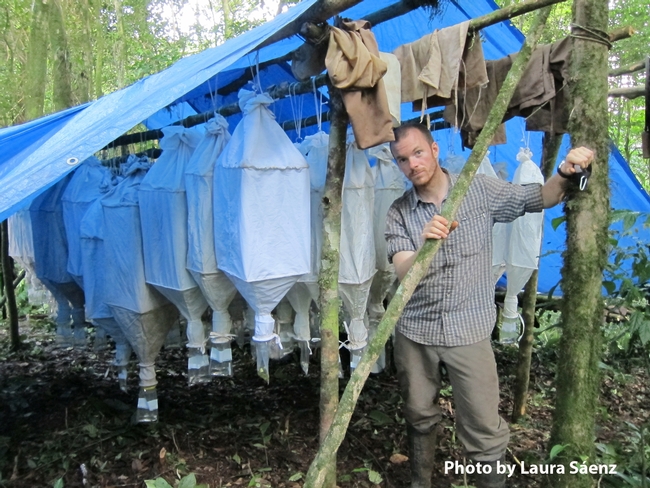
"Ants are the most successful group of social insects on the Earth," says Branstetter, Postdoctoral Fellow at the Smithsonian Institution, Washington, D.C. and a UC DAvis alumnus. "They occur in almost all terrestrial habitats and are often numerically dominant and ecologically important. Furthermore, ants are diverse. There are likely to be more than 20,000 species worldwide and among these species there is a staggering amount of morphological and behavioral variation."
"It's not just the red ant and black ant. Some species are predatory and have large trap-jaw mandibles. Some are farmers, growing fungus gardens inside their nests. Some are parasites of other ant species, living in host nests and taking advantage of a tricked worker force. And some have huge migrating colonies that go on massive raids to collect food. The list goes on..."
Branstetter is also intrigued by the diversity and is devoted to discovering and describing species and behaviors. "Most of my work focuses on using morphology and genetic data to determine what species are, but I also spend lots of time in the field making direct observations about behavior and ecology."
Branstetter, who received his doctorate in entomology in June 2012 from UC Davis (major professor Phil Ward), will speak on ”Uncovering the Origins of a Middle American Ant Radiation: Insights from Natural History, Biogeography and Molecular Data” from 12:10 to 1 p.m., Wednesday, Jan. 16 in Room 1022 of the Life Sciences Addition, corner of Hutchison and Kleiber Hall drive. His seminar will double as his exit seminar.
Born in Toledo, Ohio, Branstetter grew up in Kalamazoo, Mich. "It was not until I entered college at The Evergreen State College in Washington state that I became interested in science and eventually entomology," he says. His passion for entomology ignited in a class on "Insects and Plants of Washington" taught by Jack Longino.
That prompted Branstetter to specialize in myrmecology, the scientific study of ants.

He was hooked. Next: Graduate school at UC Davis.
The ants (genus Stenamma) that Branstetter studies are "special because they are an example of a group that originated in the temperate zone and later dispersed into the tropics. Within the tropics they have radiated in mid- to high-elevation wet forests, sometimes becoming the most dominant ant. This is in contrast to most other ants, which usually peak in diversity and abundance in the lowlands."
"It is my hope that studying Stenamma diversity and ecology will yield insights into the factors that have helped ants become so successful," Branstetter says. "Also, the genus has many undescribed species in Middle America. Describing these species and making identification keys will allow others, such as ecologists or conservation biologists, to identify them in their work. Of particular importance are the montane species, which may be in danger of extinction due to climate change."
If you miss Branstetter's seminar, not to worry. It will be recorded for later viewing on UCTV.
Attached Images:

Michael Branstetter at Reserva Nacional Kahka Creek, Nicaragua. He is in the process of doing a transect of mini Winkler samples. (Photo by Laura Sáenz)

Michael Branstetter with a Winkler hanging structure, which was constructed in the forest by his guide using only a machete. (Photo by Laura Sáenz)